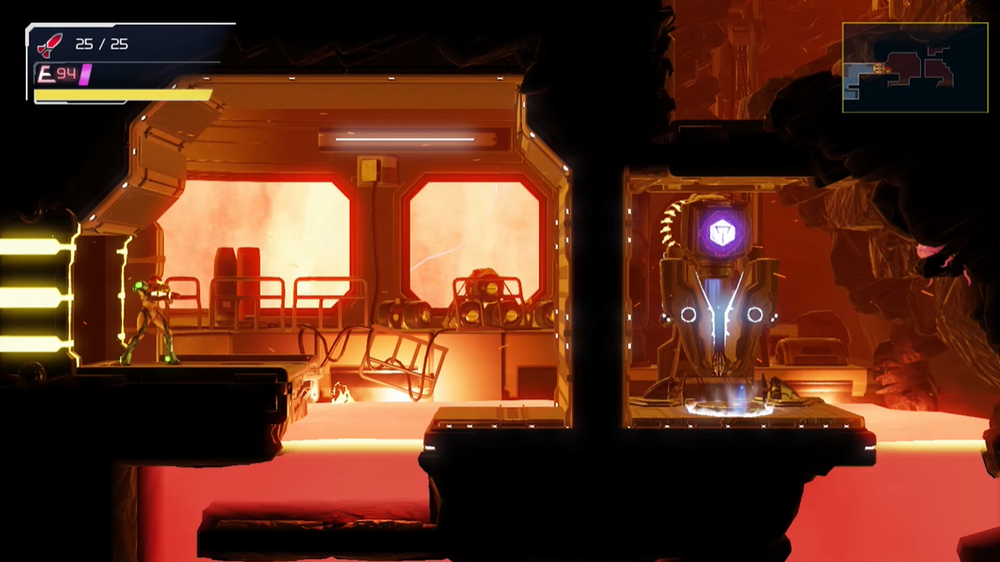How to power a planet with lava

Metroid Dread, the latest installment in Nintendo's long-running Metroid franchise, has a lot to like. There's an expansive alien cave system to explore, autonomous killer robots to flee from, and an omnipresent sense of, well, dread, that conjures up science fiction-horror classics like Alien and The Thing. But as a professional energy nerd, there's something else about Dread that caught my attention early on: ZDR, the planet it takes place on, was once home to an advanced civilization that powered their entire world with magma.
Humans have long used heat from the planet's interior to produce energy, mainly by drilling into shallow underground pockets of hot water and steam. But turning molten rock into megawatts is a different beast entirely. Metroid Dread isn't the first science fiction or the first video game to suggest it can be done: volcanic heat is a crucial energy source on Sith Lord hideout Mustafar, and it can be used to light torches and cook food in The Legend of Zelda: Breath of the Wild. But after running through Cataris, an abandoned industrial facility filled with machines that pump power-producing magma throughout ZDR's labyrinthian underworld, I had to know if there was a scientific basis for this wacky idea.
As it turns out, there is. For more than a decade, scientists working in volcanically spectacular Iceland have been exploring the possibility of extracting thermal energy from magma—and they've made some exciting progress.

Situated atop a magma hotspot that straddles the Mid-Atlantic Ridge, Iceland is a world leader in geothermal energy, which accounts for nearly a third of the nation's electricity and heats nine out of every ten households. Today, most of that energy comes from conventional geothermal wells drilled to a depth 2 or 3 kilometers. But in the future, it might come from much deeper and much hotter places, including wells bored directly into magma.
"We can fly rockets to the Moon and go to Mars, so this should be a piece of cake, really," geologist Guðmundur Friðleifsson told The Science of Fiction.
Friðleifsson heads up the Iceland Deep Drilling Project (IDDP), a long-term research program funded by energy companies, multinational organizations, and the U.S. National Science Foundation. The IDDP's main goal is to harness 'supercritical fluids' — very hot, very high-pressure water that's not quite a liquid or a gas — for energy. In theory, geothermal wells tapping supercritical fluids can produce up to ten times more energy than conventional ones. To find out whether it's economically feasible to do so, the IDDP is drilling holes nearly 5 kilometers deep, into a hellish underworld where temperatures exceed 400 degrees Celsius and pressures are over 200 times greater than they are at Earth's surface.
The team's first deep drilling attempt took place in 2008-2009 at the Krafla caldera in northeast Iceland. While the plan was to drill a 4.5-kilometer borehole, at about 2.1 km, the researchers encountered a surprise: molten rock. The drillers, Friðleifsson says, hit a small magma pocket several kilometers above the volcano's main magma chamber. Although they hadn't yet reached supercritical pressures, the IDDP team decided it couldn't pass up the opportunity to try producing energy from magma, which had never been done before.
The findings were promising. The researchers succeeded in pumping cold water down the borehole and generating superheated steam, creating the world's first "magma enhanced geothermal system." Production tests showed that the well was capable of generating up to 36 megawatts of power, more than the most powerful wind turbines on the market today.
The next step was to hook the magma-powered well up to the electric grid via a nearby power plant. But following a valve failure in 2012, the well had to be shut down. Despite this setback, the demonstration electrified the scientific community, inspiring a group of volcanologists and geothermal engineers to begin work on the Krafla Magma Testbed in 2014. That project, which seeks to become the world's first "international magma observatory," has the explicit goal of advancing R&D on geothermal magma power. Project lead John Eichelberger of the University of Alaska Fairbanks told The Science of Fiction that Krafla Magma Testbed has raised $4 million for its initial drilling design phase and that the team feels it has "good prospects" to drill its first borehole into magma in 2024.
The IDDP, meanwhile, is still going strong. In 2017, the team finished drilling its second deep well at the Reykjanes geothermal field in southwest Iceland. This time, they managed to reach the supercritical zone some 4.5 kilometers down. Due to a series of technical setbacks, engineers have yet to "flow test" the well to determine how much energy it can produce, but Friðleifsson is hoping that the test can be completed in 2022. The IDDP team is also planning to drill a third well at the Hengill geothermal field near Reykjavik within the next 5 years.
While it may be years before all of the technical challenges are worked out and homes across Iceland and beyond are heated by magma deep underground — a major issue is that the materials used to line geothermal wells are more prone to cracking and failure at very high temperatures — Iceland's geothermal power industry is watching the R&D progress with keen interest. A supercritical well, Friðleifsson says, might cost three times as much to drill as a conventional one, but if it produces ten times more power, the payoff could be well worth it.
It's not inconceivable that an advanced species on a distant world realized the same thing and invested the resources needed to make this futuristic power source a reality, as the Chozo who built Metroid Dread's magma mining facilities seem to have done. It's a feat of science and engineering that makes the lost alien race all the more impressive, and their eventual downfall all the more alarming.